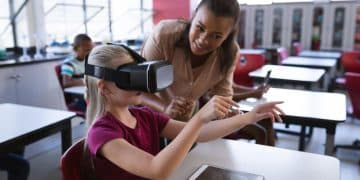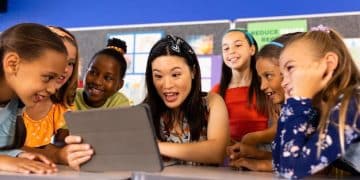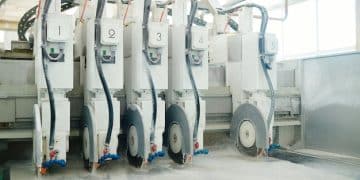US Schools: Preparing Students for Automated Future Work
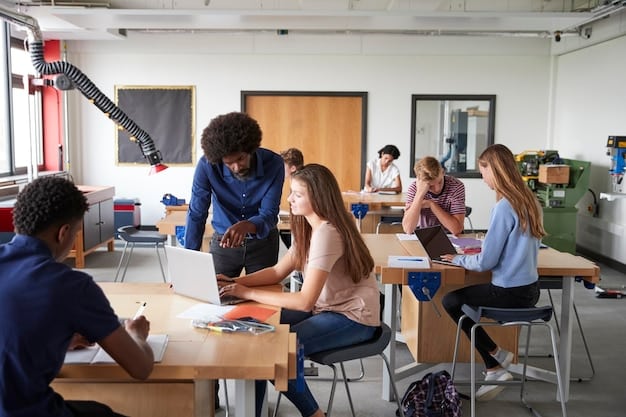
To prepare students for the future of work in an increasingly automated world, US schools must prioritize adaptable skills, foster critical thinking, integrate technology, and create dynamic curricula that continuously evolve with industry needs, ensuring graduates are equipped for lifelong learning and innovation.
In an era defined by rapid technological advancement, a fundamental question emerges for educators and policymakers: How Can US Schools Prepare Students for the Future of Work in an Increasingly Automated World? The landscape of employment is shifting dramatically, demanding a re-evaluation of traditional pedagogical approaches. As artificial intelligence and robotics become more ubiquitous, the emphasis shifts from rote memorization and routine tasks to skills that machines cannot easily replicate—creativity, critical thinking, and emotional intelligence.
Understanding the Shifting Labor Landscape
The rise of automation and artificial intelligence is reshaping industries globally, and the United States is no significant exception. This transformation presents both challenges and unparalleled opportunities for the workforce. Traditional jobs susceptible to digitization and mechanization are evolving or disappearing entirely, making way for new roles that demand different skill sets. Educators must grasp the nuances of this shift to effectively guide students toward a thriving future.
It’s no longer just about acquiring a specific set of technical skills; it’s about fostering adaptability and resilience. The jobs of tomorrow may not even exist today, underscoring the need for an education system that cultivates lifelong learners. This means moving beyond static curricula and embracing dynamic learning environments that can respond quickly to technological advancements.
The Impact of AI and Robotics
Artificial intelligence, machine learning, and advanced robotics are already integrated into various sectors, from manufacturing and logistics to healthcare and finance. These technologies are automating repetitive tasks, analyzing vast datasets, and even performing complex cognitive functions previously thought to be exclusive to humans. The implications for the job market are profound, requiring a workforce that can work alongside intelligent systems rather than merely competing with them.
- AI is streamlining operations, increasing efficiency, and creating new service models.
- Robotics is enhancing productivity in manufacturing, logistics, and even intricate surgical procedures.
- The demand for roles involving human-AI collaboration, data interpretation, and ethical AI development is growing.
Understanding the fundamental principles of AI and automation, even at a basic level, will be crucial for all students, transcending specific career paths. This foundational knowledge empowers them to interact effectively with automated systems and identify new opportunities created by these technologies.
Emerging Skill Demands
The skills most valued in an automated world are often those that leverage uniquely human attributes. While technical proficiency remains important, soft skills are gaining significant traction. Employers are increasingly looking for individuals who can think critically, adapt to new situations, solve complex problems creatively, and collaborate effectively across diverse teams.
- Critical Thinking and Problem-Solving: The ability to analyze information, identify problems, and develop innovative solutions.
- Creativity and Innovation: Generating new ideas, approaches, and solutions that automated systems cannot yet replicate.
- Emotional Intelligence: Understanding and managing one’s own emotions, and discerning and influencing the emotions of others, essential for effective teamwork and leadership.
- Adaptability and Lifelong Learning: The willingness and capacity to learn new skills and adjust to changing environments throughout one’s career.
These emerging skill demands necessitate a pedagogical shift from content delivery to skill development, emphasizing experiential learning and real-world application. Schools must become incubators for these future-proof capabilities.
In conclusion, the first step in preparing students is for schools to truly understand the current and projected state of the labor market. This comprehension allows for the strategic redesign of educational programs to align with the needs of an increasingly automated, yet human-centric, future.
Curriculum Innovation and Skill Development
To effectively prepare students for an automated future, US schools must embark on significant curriculum innovation, moving beyond traditional structures to prioritize future-ready skills. This involves integrating interdisciplinary approaches, fostering digital literacy, and emphasizing transferable competencies that remain relevant regardless of technological shifts.
The goal is to cultivate agile thinkers and problem-solvers who can navigate complex challenges, not just master specific tools. This requires a curriculum that is continuously reviewed and updated, informed by projections of workforce needs and technological advancements.
Integrating STEM and Liberal Arts
For too long, STEM (Science, Technology, Engineering, and Mathematics) and the liberal arts have been treated as separate, almost opposing fields. However, the future of work demands a holistic approach, blending the analytical rigor of STEM with the critical thinking, communication, and ethical reasoning fostered by the liberal arts. This fusion creates well-rounded individuals capable of both technical execution and nuanced understanding.
- STEAM instead of STEM: Incorporating Arts into STEM, promoting design thinking, creativity, and aesthetic appreciation in problem-solving.
- Ethical AI Education: Teaching the societal and ethical implications of technology alongside its technical aspects.
- Communication in Technical Fields: Emphasizing clear and persuasive communication for engineers, scientists, and data analysts.
This integration encourages students to think creatively about technological solutions while considering their broader human impact. It prepares them for roles where technical expertise is enhanced by empathy and effective collaboration.
Developing Digital Fluency and Data Literacy
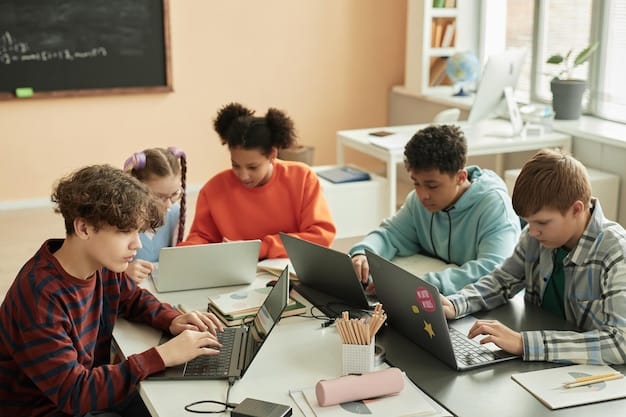
Digital fluency extends far beyond basic computer skills; it encompasses the ability to effectively use, understand, and create with digital technologies. Data literacy is equally crucial, enabling individuals to interpret, analyze, and communicate insights from vast amounts of data, a skill becoming indispensable across all sectors.
- Computational Thinking: Introducing concepts like algorithms, data analysis, and problem decomposition from an early age.
- Coding and Programming: Providing opportunities for students to learn basic to advanced coding, fostering logical reasoning and problem-solving.
- Media Literacy: Teaching students to critically evaluate digital information, identify biases, and understand the impact of online content.
By cultivating strong digital fluency and data literacy, schools empower students to be creators and critical consumers of technology, rather than passive users. This foundational knowledge is essential for nearly any future career path in an automated world.
Fostering Soft Skills Through Project-Based Learning
Project-based learning (PBL) provides an ideal framework for developing cross-functional soft skills that are highly valued in the modern workforce. By engaging in real-world, complex projects, students naturally develop critical thinking, collaboration, communication, and problem-solving abilities in an authentic context.
Instead of relying solely on lectures and tests, PBL encourages students to take ownership of their learning, work in teams, manage resources, and present their findings. This approach mirrors the collaborative and dynamic nature of contemporary workplaces, preparing students not just for content mastery but for practical application.
In essence, curriculum innovation is about future-proofing education. By strategically blending disciplinary knowledge with critical skills, US schools can equip students to not only adapt to but also shape the automated world they will inherit.
Teacher Professional Development and Support
The effectiveness of any educational reform hinges significantly on the capabilities and preparedness of educators. For US schools to successfully prepare students for the future of work in an automated world, investment in robust teacher professional development and ongoing support is paramount. Teachers must not only understand emerging technologies but also master innovative pedagogical approaches that cultivate 21st-century skills.
Transforming educational practices requires a shift in mindset and a continuous learning journey for the entire teaching staff. Without empowering teachers, even the most well-designed curricula will struggle to deliver their intended impact.
Equipping Teachers with Future-Ready Skills
Many educators themselves may lack deep familiarity with concepts like AI, data science, or advanced automation. Professional development programs must bridge this knowledge gap, providing teachers with both theoretical understanding and practical application of these technologies. This enables them to confidently integrate relevant concepts into their lessons, regardless of their specific subject area.
- AI and Data Literacy Training: Workshops focused on understanding the basics of AI, machine learning, and data interpretation, tailored for educators.
- Coding and Computational Thinking: Providing opportunities for teachers to learn foundational coding concepts and computational thinking strategies.
- Cybersecurity Awareness: Educating teachers on digital safety and best practices to incorporate into their lessons.
Beyond technical skills, teachers also need training in fostering soft skills. This includes methodologies for facilitating critical thinking, promoting collaborative problem-solving, and encouraging creative expression through diverse learning activities.
Fostering Innovative Pedagogical Approaches
Traditional teaching methods, often lecture-based and focused on memorization, are ill-suited for preparing students for a dynamic and automated future. Teachers need training in innovative pedagogies that encourage active learning, inquiry, and real-world application. This transformation moves them from being mere content deliverers to facilitators of learning and critical thought.
- Project-Based Learning (PBL) Implementation: Intensive training on designing and managing effective PBL units that integrate multiple subjects and skills.
- Inquiry-Based Learning: Developing teachers’ abilities to guide student-led investigations and foster curiosity.
- Personalized Learning Strategies: Training in leveraging technology and diverse resources to tailor instruction to individual student needs and learning styles.
This pedagogical shift requires ongoing coaching and peer collaboration. Teachers benefit immensely from shared experiences, best practices, and collaborative lesson planning that integrates new techniques.
Creating a Culture of Continuous Learning
The pace of technological change means that one-off professional development sessions are insufficient. Schools must cultivate a sustained culture of continuous learning for their staff. This involves dedicated time for professional growth, access to up-to-date resources, and opportunities for teachers to experiment with new approaches without fear of immediate failure.
Support structures, such as dedicated technology coaches, mentors, and collaborative learning communities, are crucial. When teachers feel supported and empowered to innovate, they are more likely to embrace the challenges of preparing students for a future that is constantly evolving.
Ultimately, investing in teachers is investing in the future of students. By equipping educators with the necessary knowledge and pedagogical tools, US schools can establish a strong foundation for a workforce ready to thrive in an automated world.
Leveraging Technology for Enhanced Learning
In an increasingly automated world, it’s not enough for US schools to merely teach about technology; they must effectively leverage technology to enhance the learning process itself. Integrating digital tools and platforms can personalize education, provide interactive experiences, and connect students to global resources, mirroring the digital environments they will encounter in their future careers.
Effective technological integration goes beyond simply putting devices in students’ hands. It involves thoughtful curriculum design, robust infrastructure, and professional development that empowers educators to use technology strategically for deeper learning outcomes.
Personalized Learning Pathways
Technology enables schools to move away from a one-size-fits-all approach to education. Adaptive learning platforms, AI-powered tutoring systems, and digital resource libraries can tailor content and pace to individual student needs, strengths, and learning styles. This personalization maximizes engagement and allows students to progress at their own optimal rate, reinforcing concepts where needed and accelerating when ready.
- Adaptive Software: Utilizing programs that adjust difficulty and content based on student performance.
- Curated Digital Resources: Providing access to a wide array of online learning materials, videos, and simulations to complement classroom instruction.
- Data Analytics for Educators: Empowering teachers with actionable insights from student performance data to inform instructional decisions.
Such personalized pathways ensure that every student builds a strong foundation, addressing gaps early and challenging advanced learners appropriately, thereby preparing them for diverse academic and professional pursuits.
Virtual and Augmented Reality in Education
Virtual Reality (VR) and Augmented Reality (AR) offer immersive learning experiences that can bring abstract concepts to life and provide practical training in a safe, controlled environment. These technologies transcend the limitations of traditional textbooks, allowing students to explore historical sites, dissect virtual organisms, or practice complex surgical procedures.
- Virtual Field Trips: Immersive explorations of remote locations, historical events, or scientific phenomena.
- Practical Skill Simulation: Training for technical trades, medical procedures, or engineering tasks in a virtual setting.
- Interactive 3D Models: Visualizing complex structures, from human anatomy to molecular compounds, in an engaging way.
By providing realistic simulations and interactive models, VR and AR enhance engagement, improve retention, and offer invaluable experiential learning opportunities that prepare students for real-world applications in future automated industries.
Ensuring Equitable Access to Technology
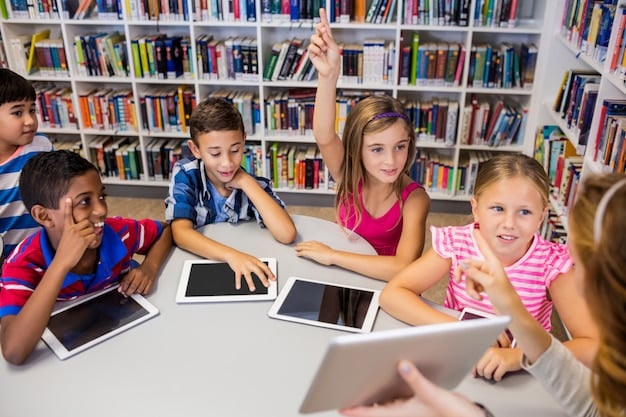
While technology offers immense potential, its benefits can only be fully realized if there is equitable access for all students. The digital divide remains a significant challenge, particularly in underserved communities. Schools must prioritize providing reliable internet access, adequate devices, and necessary technical support to every student, ensuring no one is left behind in the journey toward digital literacy.
Policies should be implemented to guarantee device availability, whether through school-loan programs or community partnerships. Additionally, technical support and digital literacy workshops for families can help bridge the gap outside of school hours, fostering a more inclusive learning environment.
Effectively leveraging technology in education is not merely about keeping pace with the times; it is about fundamentally transforming how students learn, empowering them with the digital competencies and adaptable mindsets essential for success in an increasingly automated professional world.
Fostering Entrepreneurship and Innovation
In an automated future, the workforce will require individuals who are not just job seekers but job creators. US schools must therefore actively foster an entrepreneurial mindset and cultivate skills in innovation. This involves moving beyond traditional career paths and empowering students to identify opportunities, develop novel solutions, and navigate the uncertainties inherent in a rapidly changing economy.
Entrepreneurship education is not solely about starting a business; it’s about instilling a proactive, resilient, and adaptive approach to challenges, skills that are invaluable in any career or life endeavor.
Developing an Entrepreneurial Mindset
An entrepreneurial mindset encompasses a set of attitudes and behaviors that are crucial for navigating complexity and driving progress. These include risk-taking (within reason), persistence, creativity, self-reliance, and the ability to learn from failure. Schools can cultivate these traits through curriculum design and extracurricular activities that encourage experimentation and problem-solving.
- Ideation Workshops: Providing structured environments for students to brainstorm and develop novel ideas.
- Design Thinking Challenges: Engaging students in processes that identify user needs and prototype solutions.
- Pitch Competitions: Offering opportunities for students to articulate their ideas, receive feedback, and refine their communication skills.
By normalizing experimentation and learning from mistakes, schools can create an environment where students feel empowered to innovate and take initiative, rather than simply follow instructions.
Promoting Creative Problem-Solving
Automation excels at executing defined tasks, but it struggles with ill-defined problems that require novel, human-centric solutions. Therefore, schools must prioritize the development of creative problem-solving skills. This involves encouraging divergent thinking, fostering interdisciplinary collaboration, and providing real-world challenges that demand innovative approaches.
Incorporating arts education alongside STEM subjects can significantly boost creative capacities. Arts foster imagination, intuition, and the ability to approach problems from multiple perspectives—qualities that are increasingly valuable as routine tasks become automated.
Students should be encouraged to question assumptions, challenge existing paradigms, and envision alternative futures. This nurturing of curiosity and inventive thinking is central to preparing them to innovate in any field.
Connecting with Industry and Community
To provide relevant entrepreneurial and innovative experiences, schools should forge strong partnerships with local businesses, startups, and community organizations. These connections offer students real-world insights, mentorship opportunities, and the chance to apply their learning to authentic problems faced by companies and communities.
- Internships and Apprenticeships: Providing early exposure to professional environments and practical industry experience.
- Mentorship Programs: Connecting students with entrepreneurs, innovators, and industry leaders who can offer guidance and inspiration.
- Guest Speakers and Workshops: Bringing in professionals to share their experiences and teach specialized skills.
Such partnerships not only enrich the learning experience but also create valuable networking opportunities for students, potentially seeding future entrepreneurial ventures and helping them understand the practicalities of launching new initiatives.
In essence, fostering entrepreneurship and innovation is about empowering students to be proactive agents of change. By cultivating these skills, US schools can prepare a generation of individuals who are ready to create their own opportunities and contribute meaningfully to the evolving economy.
Developing Ethical and Social AI Awareness
As artificial intelligence becomes more pervasive, it’s not enough for students to merely understand how AI works; they must also grasp its profound ethical and social implications. US schools have a critical role in developing students’ ethical literacy regarding AI, ensuring they can critically analyze its societal impact, understand biases, and contribute to the responsible development and deployment of intelligent systems.
This awareness transcends technical proficiency, delving into the human values that underpin technology. It prepares students not just to use AI, but to guide its future, ensuring it serves humanity rather than creating unintended consequences.
Understanding Algorithmic Bias and Fairness
AI systems are only as unbiased as the data they are trained on, and unfortunately, historical human biases can be inadvertently encoded into algorithms. Students need to understand how algorithmic bias can emerge, its potential impact on fairness in areas like hiring, credit, and justice, and how to identify and mitigate such biases. This encourages a critical and discerning approach to AI technologies.
- Case Studies: Examining real-world examples of AI bias and their societal consequences.
- Data Ethics: Discussing the ethical collection, use, and interpretation of data.
- Bias Detection: Introducing basic concepts of how to identify and address bias in AI systems.
By fostering an understanding of algorithmic bias, schools empower students to advocate for fair and equitable AI systems, becoming conscientious users and developers of future technologies.
Privacy and Data Security Education
In an automated world driven by data, understanding privacy and data security is paramount. Students must be educated on the value of personal data, how it is collected and used by AI systems, and the importance of cybersecurity practices. This knowledge empowers them to protect their digital footprint and make informed decisions about their online interactions.
From understanding privacy policies to recognizing phishing scams, these skills are essential for personal safety and professional responsibility. It also involves teaching about data governance and the responsibilities of organizations in protecting user information.
Schools can implement practical exercises, such as analyzing real-world privacy policies or identifying secure online behaviors, to make these concepts tangible and relevant for students in their daily lives.
The Future of Work and Societal Impact of AI
Beyond individual skills, students should engage in broader discussions about the macro-level impact of AI on society and the future of work. This includes exploring topics such as job displacement and creation, the need for reskilling and lifelong learning, and the potential for AI to exacerbate or alleviate social inequalities.
Encouraging students to think critically about these challenges prepares them to participate in informed public discourse and contribute to policy decisions regarding AI deployment. It also instills a sense of social responsibility in their careers, regardless of the field they pursue.
Developing ethical and social AI awareness is not just about preparing students for jobs; it’s about preparing them to be responsible citizens and leaders in a world increasingly shaped by intelligent machines. This critical understanding ensures that technological progress aligns with human values.
Rethinking Assessment and Credentialing
To genuinely prepare students for the future of work in an increasingly automated world, US schools must also critically rethink their assessment and credentialing practices. Traditional methods often focus on memorization and standardized tests, which may not accurately measure the complex skills valued in an evolving economy. A shift toward authentic assessment and diverse credentialing pathways is crucial.
The goal is to assess what truly matters: a student’s ability to apply knowledge, solve real-world problems, collaborate effectively, and adapt to new challenges, rather than just recall isolated facts.
Moving Beyond Standardized Testing
While standardized tests can provide some baseline data, they often fail to capture higher-order thinking skills, creativity, or the ability to work in teams—precisely the competencies that automation cannot easily replicate. Schools should explore alternatives that offer a more holistic and authentic measure of student learning and skill development.
- Performance-Based Assessments: Evaluating students through projects, presentations, and real-world simulations.
- Portfolios: Collecting and showcasing a student’s best work over time, demonstrating growth and skill mastery.
- Rubric-Based Evaluations: Providing clear criteria for assessing complex tasks, offering specific feedback beyond a single score.
These alternative assessment methods provide a richer picture of student capabilities, aligning assessment with the very skills that are critical for success in future careers.
Embracing Micro-Credentials and Digital Badges
The traditional diploma or degree may not always fully convey the nuanced skill sets acquired by a student. Micro-credentials and digital badges offer a flexible and granular way to recognize specific competencies, often earned through smaller, focused learning experiences. They provide a transparent, verifiable record of skills acquired, making it easier for employers to identify specific talents.
- Skill-Specific Badges: Certifying proficiency in areas like data analysis, cybersecurity, or advanced coding.
- Soft Skill Recognition: Acknowledging demonstrated abilities in collaboration, leadership, or critical problem-solving.
- Continuing Education Units: Allowing for ongoing skill acquisition and validation outside of traditional degree programs.
Implementing micro-credentialing creates a more modular and agile system of recognition, reflecting the continuous learning necessary in an automated environment. Students can accumulate a “stack” of verifiable skills relevant to their evolving career paths.
Promoting Lifelong Learning Portfolios
In an automated world defined by continuous change, education doesn’t end with graduation. Schools should instill the concept of lifelong learning and encourage students to maintain dynamic portfolios of their achievements, projects, and acquired skills throughout their professional lives. These portfolios serve as living resumes, showcasing adaptability and ongoing development.
This includes not just formal credentials but also self-directed learning, online course completions, volunteer experiences, and personal projects. The emphasis shifts from a fixed endpoint of education to an ongoing journey of skill acquisition and refinement.
Rethinking assessment and credentialing is about valuing a broader spectrum of abilities and providing more relevant and flexible indicators of student readiness. By doing so, US schools can better prepare individuals for a future where adaptability and continuous skill-building are paramount.
Building Human-Centered Skills and Well-being
In the push to prepare students for an automated future, it’s crucial that US schools don’t overlook the development of uniquely human-centered skills and the promotion of well-being. Automation will increasingly handle routine and cognitive tasks, elevating the importance of qualities like empathy, collaboration, creativity, and resilience. Education must intentionally cultivate these attributes, ensuring students thrive professionally and personally.
The future of work is not just about technological proficiency; it’s also about fostering robust human capabilities that complement, rather than compete with, machines.
Cultivating Empathy and Collaboration
As machines take on more analytical roles, human interaction, negotiation, and teamwork become even more critical. Empathy—the ability to understand and share the feelings of others—is foundational for effective collaboration, conflict resolution, and leadership. Schools can foster these skills through cooperative learning activities, community projects, and emphasis on diverse perspectives.
- Team-Based Projects: Requiring students to work collaboratively on real-world challenges, negotiating roles and responsibilities.
- Service Learning: Engaging students in community service that exposes them to diverse needs and fosters compassion.
- Cross-Cultural Understanding: Promoting awareness and appreciation of different cultures and viewpoints to enhance global collaboration.
These experiences help students develop the interpersonal skills necessary to navigate complex group dynamics and function effectively in diverse, globally connected workplaces.
Nurturing Creativity and Innovation
While AI can generate data-driven ideas, true creativity—the ability to form novel concepts and solutions that transcend existing patterns—remains a distinct human advantage. Schools must provide ample opportunities for students to engage in creative expression across all subject areas, encouraging imaginative thinking and divergent problem-solving.
This includes incorporating arts and design, fostering open-ended challenges, and creating spaces where experimentation and even “failure” are seen as learning opportunities. The emphasis should be on the process of ideation and iteration, not just the final product.
By nurturing creativity, schools equip students to innovate, adapt to unforeseen challenges, and contribute unique perspectives that automated systems cannot replicate.
Prioritizing Mental and Emotional Well-being
The rapidly changing world, with its technological advancements and uncertainties, can also bring increased stress and anxiety. Schools have a responsibility to prioritize students’ mental and emotional well-being, fostering resilience, self-awareness, and coping mechanisms. A healthy mind is better equipped to learn, adapt, and navigate professional and personal challenges.
- Social-Emotional Learning (SEL): Integrating curricula that teach self-management, self-awareness, responsible decision-making, and relationship skills.
- Mindfulness Practices: Introducing techniques to reduce stress and improve focus.
- Access to Support Services: Ensuring students have access to counselors and mental health resources.
By focusing on well-being, schools are not just preparing students for a job; they are preparing them for a fulfilling life, equipped with the emotional fortitude and self-awareness to thrive in any future landscape.
Ultimately, a human-centered approach to education ensures that as technology advances, humanity’s core strengths are amplified. By developing these essential skills and supporting holistic well-being, US schools can prepare a generation that is not only ready for the future of work but also capable of shaping it with compassion and purpose.
| Key Area | Brief Description |
|---|---|
| 💡 Curriculum Innovation | Integrate STEM with Liberal Arts, develop digital literacy, and foster essential transferable skills. |
| 👩🏫 Teacher Development | Equip educators with future-ready skills and innovative pedagogical approaches for dynamic learning. |
| 💻 Tech Integration | Leverage technology for personalized pathways, immersive learning, and ensure equitable access for all. |
| 🚀 Entrepreneurship | Foster innovation, creative problem-solving, and connections with industry for real-world application. |
Frequently Asked Questions About Future Work Readiness
The most crucial skills include critical thinking, complex problem-solving, creativity, emotional intelligence, and adaptability. While technical skills remain important, the ability to innovate, collaborate, and navigate ambiguity is increasingly vital. Lifelong learning is also
paramount as job roles continue to evolve.
Schools can integrate AI by focusing on fundamental concepts like computational thinking and data literacy, rather than just tools. This means teaching how algorithms work, the ethics of AI, and its societal impact. Project-based learning can offer practical applications without requiring deep technical expertise from every student.
Soft skills like communication, teamwork, leadership, and emotional intelligence are increasingly critical. Automation handles routine tasks, making uniquely human skills more valuable. Employers seek individuals who can collaborate effectively, resolve conflicts, and adapt to dynamic environments, emphasizing human interaction over repetitive tasks.
Addressing the digital divide requires providing equitable access to reliable internet and devices for all students, regardless of socioeconomic background. Schools can implement device loan programs, establish community tech hubs, and offer digital literacy training for families to ensure universal participation in technology-enhanced learning.
While coding is valuable, it’s not universally essential for every student to become a programmer. Crucially, all students need strong digital fluency, computational thinking, and data literacy. Understanding how technology works, evaluating digital information critically, and ethical AI awareness are equally, if not more, important for future readiness.
Conclusion: Charting a Course for Future-Ready Education
The journey to effectively prepare US students for the future of work in an increasingly automated world is complex but undeniably vital. It demands a holistic transformation of the educational system, moving beyond traditional paradigms to embrace innovation, adaptability, and human-centric skills. By integrating interdisciplinary curricula, investing in teacher development, leveraging technology strategically, fostering entrepreneurial mindsets, and prioritizing ethical AI awareness and well-being, schools can equip a generation not just to survive, but to truly thrive. This proactive approach ensures that students are not merely recipients of knowledge, but active creators, critical thinkers, and empathetic leaders capable of shaping a future where humanity and technology progress in harmony. The challenge is significant, yet the opportunity to redefine what it means to be educated for the 21st century and beyond is within reach.
